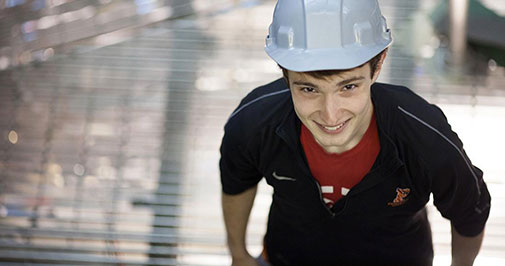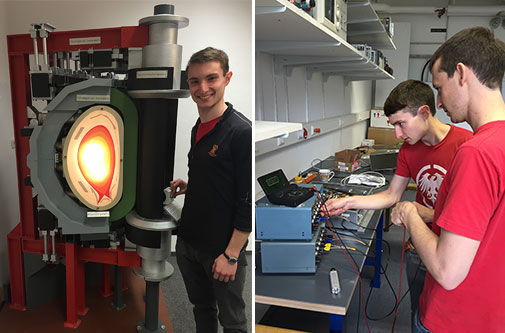NSE’s Creely wins prestigious DoD fellowship

NSE graduate student Alexander Creely has been awarded a National Defense Science and Engineering Graduate (NDSEG) Fellowship. This highly competitive, portable fellowship is awarded to graduate students who have demonstrated the ability and special aptitude for advanced training in science and engineering, and intend to pursue a doctoral degree in one of fifteen supported disciplines. Creely receives this fellowship in physics for his graduate studies exploring turbulence and transport in fusion plasmas with NSE professor Anne White.
Turbulence and transport in fusion plasmas remain some of the most difficult phenomena to understand in the area of plasma physics. Better understanding these phenomena, and being able to predict turbulence and transport in a variety of plasma conditions, will be vital to the design and operation of future fusion devices. In particular, the differences in turbulence and transport between different confinement regimes in tokamaks, such as L-mode, I-mode, and H-mode, may well determine which regime would be most favorable for a fusion reactor.
Creely conducts his research at MIT and in Germany. His work focuses on characterizing the turbulence and transport properties of L- and I-mode plasmas. “First, we can directly measure turbulence with newly constructed correlation electron cyclotron emission (CECE) diagnostics on Alcator C-Mod here at MIT and on ASDEX Upgrade in Germany.” said Creely. “In addition, overall transport in the plasma is characterized by larger scale power balance calculations and measurement of heat pulses as they propagate through the plasma. All of this information is then compared to simulations of plasma turbulence, with the goal of validating these simulations and preparing the codes to predict future plasmas.”

”Alex’s excellence in research is well-balanced with his overall excellence in academic achievements, extra-curricular activities, and his dedication to service in the MIT community,” said Creely’s thesis advisor,Anne White. ”Alex has been an outstanding group member helping establish a new international fusion research collaboration, he’s published a first author paper this year, he will participate in a MISTI internship at a fusion device in Japan this summer, he will be starting as a GRT next year, he has significantly contributed in the NSE undergrad electronics class 22.071 to guide students during daily labs and during design projects, and he also participates in many education and outreach efforts at the Plasma Science and Fusion Center.”
NDSEG Fellowships last for three years and pay for full tuition and all mandatory fees, a monthly stipend, and up to $1,000 a year in medical insurance.
The Department of Defense, which confers this fellowship, is committed to increasing the number and quality of scientists and engineers in the U.S. It has awarded approximately 3,200 NDSEG fellowships since the program’s inception 22 years ago. The NDSEG Fellowship is sponsored by the Air Force Office of Scientific Research (AFOSR), the Army Research Office (ARO), the High Performance Computing Modernization Program (HPCM), and the Office of Naval Research (ONR), under the direction of the Director of Defense Research and Engineering (DDR&E).
Top: Alex Creely at the PSFC, MIT. Middle of page — Left: MIT grad student Alex Creely standing next to scale model of the ASDEX Upgrade tokamak at the Max Planck Institute for Plasma Physics in Germany. Right: Alex, and postdoc Simon Freethy (pictured at right below working in the lab in Germany) have designed, constructed, and fielded new turbulence diagnostics this year at ASDEX Upgrade, and with them, have made the first measurements of electron temperature fluctuations and correlation between density and temperature fluctuations at that tokamak.
Related
- Thirteen MIT students awarded National Defense Science and Engineering Graduate Fellowships
- Kuang, Creely already contributing to fusion’s advancement
- Understanding the turbulence in plasmas
